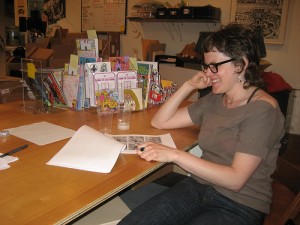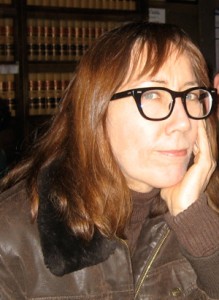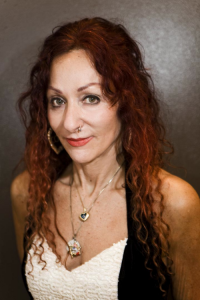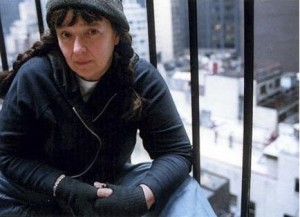Happy Women’s History Month! All through March, we’ll be celebrating women who changed free expression in comics. This week we spotlight creators who made the transition from underground to alternative comics in the 1980s and ’90s.
Follow our Tumblr every weekday for biographical snippets on female creators who have changed the face of free expression in comics by pushing the boundaries of the medium and/or seen their work challenged or banned. We’re also collecting the posts here on a weekly basis.
Lynda Barry
 Lynda Barry is one of contemporary independent comics’ most celebrated creators, known not only for her strip work in alternative weeklies from the ’70s to the ’90s, but also for her incredible biographical and autobiographical works that capture highly interpersonal and introspective aspects of her life in a way that the comics industry hasn’t seen before. A pioneer of the biographical and experimental comics form, Barry opened the door for many of the themes and styles that have taken over independent comics today.
Lynda Barry is one of contemporary independent comics’ most celebrated creators, known not only for her strip work in alternative weeklies from the ’70s to the ’90s, but also for her incredible biographical and autobiographical works that capture highly interpersonal and introspective aspects of her life in a way that the comics industry hasn’t seen before. A pioneer of the biographical and experimental comics form, Barry opened the door for many of the themes and styles that have taken over independent comics today.
Born Linda Jean Barry in Wisconsin in 1956, she moved with her family to Seattle, Washington shortly thereafter and spent most of her childhood there, exposed to a world of urban diversity and culture. As a young adult growing up in a time and place where the booming underground comix movement of San Francisco was just a stone’s throw away but had been in full-swing for at least a decade, the comics scene in the Pacific Northwest began changing to accommodate a more contemporary young society—a society of young intellectuals and bohemians who were searching for a new way to look at their complicated, emotionally conflicted modern world. Mixing the free press of the underground with the accessibility of a broader educated readership, alternative press—specifically alternative weeklies—was born and Lynda Barry was at the forefront of this movement representing not only the voice of men and women both, but importantly herself—a giant step that would in later years bloom into a whole genre in and of itself in the comics industry.
With her comic Ernie Pook’s Comeek, Barry was able to reach out to a new comics reader who was looking for more complex and challenging works than those that were being written for the everyday newspaper. Running for two decades and syndicated across North America in various alternative weeklies, in juxtaposition to the underground comics which remained fairly isolated to a particular community and its creators, Barry’s work and voice reached all sorts of people and places while allowing her the ability to freely express herself in a new and growing form.
As her popularity grew and the alternative weekly scene and comics changed, Barry would further grow with it, becoming not only a comics creator, but an illustrator, writer, playwright, and teacher. Using the comics form, she experimented with collage and illustration as a means to get her voice and story across. If that meant adapting her illustrated novel The Good Times are Killing Me into an off-Broadway play, so be it. It was the drive to express herself and her creativity that allowed Barry’s works to permeate a variety of audiences and ultimately act as inspiration for other contemporary comics creators.
In 2009 Barry won the prestigious Eisner Award and R.R. Donnelly Award for her graphic novel What It Is. A memoir, a graphic novel, a piece of literature, and an instructional workbook for a new generation of creators to find and express themselves through the comics medium, What It Is represents explicitly who Barry is in the motley world of comics today—a creator, an educator, and an inspiration for an industry in motion and change.
—Contributing Editor Caitlin McCabe
Julie Doucet
 Julie Doucet grew up in Montreal, where she attended an all-girls Catholic high school and later obtained a degree in printing arts from Université du Québec à Montréal. In the late 1980s she began working with experimental comics, including her fanzine Dirty Plotte which was originally self-published but was picked up by Drawn & Quarterly in 1991. That series, says D+Q on its Julie Doucet page, “changed the landscape of alternative cartooning, offering a frank, funny, and sometimes shocking melange of dreams, diaries, and stories.”
Julie Doucet grew up in Montreal, where she attended an all-girls Catholic high school and later obtained a degree in printing arts from Université du Québec à Montréal. In the late 1980s she began working with experimental comics, including her fanzine Dirty Plotte which was originally self-published but was picked up by Drawn & Quarterly in 1991. That series, says D+Q on its Julie Doucet page, “changed the landscape of alternative cartooning, offering a frank, funny, and sometimes shocking melange of dreams, diaries, and stories.”
The 1990s were literally dynamic years for Doucet, as she moved from Montreal to New York to Seattle to Berlin and finally back to Montreal in 1998. Her time in New York, she says drily on her website, “didn’t go too well” and was chronicled in My New York Diary in 1999. During those years Drawn & Quarterly also published two collections of her strips which had originally appeared in alt-weeklies and other periodicals. After returning to her hometown, she ended Dirty Plotte and started a new strip about life in Montreal called The Madame Paul Affair, which was published in collective form in 2000.
After that, Doucet declared that she was done with the comics format—too much work for not enough money, she says—and has since thrown herself into an astounding variety of other artforms including silkscreen printmaking, collage poetry, animation, and papier-mâché sculpture, all tinged with the same wry humor and bustling energy that fans know from her earlier work. She still lives in Montreal, where she now publishes her own work through her press Le Pantalitaire and is deeply involved in the arts community, often exhibiting locally as well as internationally.
—Contributing Editor Maren Williams
Carol Lay
 Carol Lay grew up in Orange County, California during the 1950s, a time and place where she says “the normality was mind-numbing.” She was able to step outside the mundane somewhat through TV shows like The Twilight Zone and Alfred Hitchcock Presents, but didn’t fully escape it until she attended UCLA, where she “discovered Frank Zappa and Zap Comix in the first week.” Lay had a wide variety of interests but majored in Fine Arts, although she was already frustrated with the field before she finished her degree. After college she created some parodic pastiches of well-known paintings (“The Persistence of Kat Klocks,” for instance), but was drawn to the practical discipline of commercial art. She worked in ad design for a few years until she hit upon the idea of creating comics, which she says suited her “skills and interests in drawing, storytelling, logic, and complex puzzle solving.”
Carol Lay grew up in Orange County, California during the 1950s, a time and place where she says “the normality was mind-numbing.” She was able to step outside the mundane somewhat through TV shows like The Twilight Zone and Alfred Hitchcock Presents, but didn’t fully escape it until she attended UCLA, where she “discovered Frank Zappa and Zap Comix in the first week.” Lay had a wide variety of interests but majored in Fine Arts, although she was already frustrated with the field before she finished her degree. After college she created some parodic pastiches of well-known paintings (“The Persistence of Kat Klocks,” for instance), but was drawn to the practical discipline of commercial art. She worked in ad design for a few years until she hit upon the idea of creating comics, which she says suited her “skills and interests in drawing, storytelling, logic, and complex puzzle solving.”
Lay got her start in the industry through lettering, then took on various jobs at independent and mainstream comics publishers including DC, Marvel, Hanna-Barbera, and Western Publishing. Meanwhile she also continued in commercial art and illustration for Mattel, and drew storyboards for both live-action and animated films. She was also able to express her more surreal sensibilities through her own independent comic Good Girls, a parody of romance comics that features an heiress who was adopted by an African tribe as an infant and received drastic facial modifications.
Throughout the 1990s and 2000s, Lay found her niche with her strip Story Minute, which later became Way Lay and appeared on Salon.com as well as in several other U.S. and international periodicals. These strips featured complete slice-of-life short stories economically packed into a page or half-page of panels, featuring characters who often wore sheepish sideways grins. Lay also delved into journalism and memoir via comics, as when she illustrated her experiences at Burning Man and the pinup convention Glamourcon. In 2008 she published a pragmatic and honest graphic memoir of her weight loss called The Big Skinny: How I Changed My Fattitude. In January 2015 Lay launched a new online strip, Lay Lines, which mixes new content with newly-colored versions of her older work. She also recently crowdfunded a new book, Murderville #1: A Farewell to Armories, in which “a semi-retired mobster and his family face down a sexy villain on a quaint Maine island.”
—Contributing Editor Maren Williams
Aline Kominsky-Crumb
 San Francisco in the 1960s and ’70s was the place to be if you were a cartoonist looking to break away from the regulations imposed on the comics industry by the Comics Code and find a public space to freely express yourself. The underground comix movement was in full force and a truly unique voice full of spit and spunk emerged from this band of creators in Aline Kominsky-Crumb.
San Francisco in the 1960s and ’70s was the place to be if you were a cartoonist looking to break away from the regulations imposed on the comics industry by the Comics Code and find a public space to freely express yourself. The underground comix movement was in full force and a truly unique voice full of spit and spunk emerged from this band of creators in Aline Kominsky-Crumb.
Born Aline Goldsmith, Kominsky-Crumb was one of the expatriates of New York and mainstream comics who migrated to San Francisco to find a new arena for their works. Alongside Trina Robbins, Lee Marrs, and a handful of other women, Kominsky-Crumb would become a founder and contributor to the longest running all-women comix anthology, Wimmen’s Comix. Like most underground creators her gritty art and unabashedly honest narrative style complemented her equally honest approach to life. Kominsky-Crumb utilized the comics form to test social boundaries, push buttons, and get in readers’ faces. It is her free and unrestrained voice and style that made her not only one of the most prominent creators in the underground, but also one of the most influential creators for the future alternative and independent comics scenes.
When she wasn’t contributing to Wimmen’s Comix, a publication by women for women, she was contributing to other underground anthologies including Robert Crumb’s Weirdo which reached a whole other kind of reader. When she wasn’t doing work for other people’s books she was making her own. Together with Diane Noomin she created Twisted Sisters, which took the underground in a whole new direction for women creators and women readers. Unlike Wimmen’s Comix whose central theme was the empowerment of women, Twisted Sisters showed women as they were with all of their mortal flaws and desires. In a University of Florida conference in 2003 Noomin recalled, “Basically, we felt that our type of humor was self-deprecating and ironic and that what they were pushing for in the name of feminism and political correctness was a sort of self-aggrandizing and idealistic view of women as a super-race. We preferred to have our flaws and show them.”
Featuring gritty art, gritty stories, and gritty women, Aline Kominsky-Crumb’s work in the underground truly was work for a whole other kind of woman. Not to be held back by any kind of boundary—gender, ethnic, social, and so on—Kominsky-Crumb has not only worked with many of the industry’s greats, but has accumulated a portfolio that could be the poster child for freedom of expression. Her unabashed approach to comics, and ultimately freedom of speech as well, is what has made Kominsky-Crumb a leading and highly influential voice for a whole new generation of creator.
—Contributing Editor Caitlin McCabe
Sue Coe
 Sue Coe grew up next to a slaughterhouse, a circumstance that has had a profound impact on her career as an artist. In witnessing the horrors of factory farming, Coe decided that her work should bring to light the atrocities in the world around us. Her stark and sobering work isn’t just limited to farms — Coe has used art to address the horrors of apartheid, systemic racism, HIV, war, and terrorism.
Sue Coe grew up next to a slaughterhouse, a circumstance that has had a profound impact on her career as an artist. In witnessing the horrors of factory farming, Coe decided that her work should bring to light the atrocities in the world around us. Her stark and sobering work isn’t just limited to farms — Coe has used art to address the horrors of apartheid, systemic racism, HIV, war, and terrorism.
Born in 1951 in England, Coe moved to the United States in 1972. Her highly political work has been featured in The New York Times, The Nation, Entertainment Weekly, The Progressive, The New Yorker, Rolling Stone, Artforum, and several other publications. Coe uses various media, including paint, collage, drawing, and more, but she considers herself more a journalist than an artist. She uses her artwork to address social issues, often juxtaposing victims and perpetrators in evocative and impactful ways, conveying dreadful events in a way that cannot be ignored by the viewer.
Because Coe’s work is so powerful, it has occasionally run afoul of censors. “The Rape of Rosa Velez,” which depicts the gang rape of a woman on a pool table, has been attacked on a few occasions. When Coe drew it for an assignment for Boston Magazine, the publication cropped the final image, removing much of the artwork’s impact in doing so. In 1984, British censors shut down a portion of an exhibition at Ferens Gallery in the UK for displaying the piece.
Regardless of the attempts to censor her, Coe continues to create work that makes a statement, and she does extensive research for her pieces. For Dead Meat (1996), which collects many of her pieces about factory farms and slaughterhouses, Coe visited stockyards, meatpacking plants, dairies, and chicken farms. The same research has influenced the pieces in her subsequent publications Sheep of Fools (2005) and Cruel (2012). Coe remains adamant that artwork should be used to address the cruelty of the world around us.
—Editorial Director Betsy Gomez
Help support CBLDF’s important First Amendment work in 2015 by visiting the Rewards Zone, making a donation, or becoming a member of CBLDF!